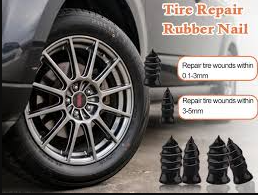Introduction
The nail in thir repair cost is far more than just a patch—it depends on where the nail is, how big the hole is, the method used to repair, and whether dangerous damage has occurred. As a tyre specialist with over a decade working in auto repair shops across different regions, I’ve seen customers surprised by hidden costs, unnecessary replacements, and unsafe repair jobs. In this guide I’ll walk you through everything you need to know: how much you should expect to pay, what influences those figures, when repair is possible (and safe), and how to avoid overpaying or compromising your safety.
1. What Is a Nail/Tire Puncture & Why It Matters
When a nail (or screw, bolt, shard of metal) penetrates the tyre, it can puncture thin layers of tread and possibly reach deeper structures (inner liner, steel belts). If the puncture is in the tread area, small (usually less than ~6 mm / ¼ inch), and central, repair is often safe. If it’s near the sidewall, or the internal structure is damaged, repair may be unsafe or impossible. Safety matters: driving on a compromised tyre risks blowouts, poor handling, and legal non-compliance.
2. Cost Ranges by Region & Repair Method
Here are realistic cost ranges depending on your region and repair method:
| Region / Service Type | Typical Cost Range | What’s Included |
|---|---|---|
| United States, shop repair | US$20 – US$50 for basic patch/plug; up to US$100+ for complex repair, luxury / specialty tyre. | |
| US, mobile truck / roadside | US$60-US$90 or more, due to travel, emergency call-outs | |
| UK standard garage / tyre centre | ~£25-£45 for typical nail-in puncture repair. | |
| UK chain centres (e.g. Halfords, Formula One Autocentres) | ~£20-£30, sometimes including balance & valve depending on shop. |
3. What Factors Drive the Cost Up or Down
- Location of the puncture: Central tread area is repairable; near sidewall or bead is often not.
- Size of the hole: Under ~6 mm is generally fixable; larger holes require replacement.
- Method of repair: Just plugging from outside is cheaper but often temporary; patch or plug+patch, especially from inside, costs more.
- Labour costs: Shops with higher hourly rates, specialised equipment, or higher overhead will charge more.
- Additional services: Tire removal, balancing, valve replacement, disposal fees, re-mounting.
- Type of tyre: Run-flats, high performance, large/oversized tyres tend to cost more.
- Emergency / mobile service: On-road calls, after hours, or mobile techs bring premium.
- Regional cost variation: Different labour rates & materials in different states/countries.
4. Repair Methods: Plug vs Patch vs Plug+Patch vs Sealant
| Method | Process | Cost Estimate | Pros | Cons |
|---|---|---|---|---|
| Plug only | Insert rubber “string” into hole from outside, trim flush. | Cheapest (~US$10-25 in many regions). | Quick; minimal dismount; good urgent fix. | Less durable; possible leak; often not accepted by safety standards alone. |
| Patch only | Remove tyre, patch from inside; more thorough. | Higher cost due to labour & dismount. | More reliable, better seal; safer long term. | Takes more time; more labour costs; shop needed. |
| Plug + Patch (“combination repair”) | Both inside patch + outside plug for strongest seal. | Highest for repair options (excluding full replacement). | Best durability; often required by many safety standards. | Highest labour/material cost; more downtime. |
| Sealant | Sealing material injected (temporary). | Low cost; often DIY or cheap service. | Quick temporary solution; can get you to a shop. | Not permanent; may interfere with proper repair; can void warranty or violate safety standards. |
5. When You Should Replace Instead of Repair
Repair may not be safe or allowed when:
- The puncture is in the sidewall or bead area.
- The hole is too large (often >6 mm / ¼ inch).
- Multiple punctures, especially close together.
- The tyre has been driven while flat, causing internal damage.
- Tread wear is below legal limit or tread is otherwise compromised.
- Previous repair(s) in same area, or structural damage (e.g. steel belts exposed).
- Manufacturer / safety / legal standards disallow repair in certain cases (e.g. run-flats).

6. Hidden Costs to Watch Out For
- Balancing: After repair, wheel/tyre may need balancing.
- Valve replacement: If the valve stem is damaged or worn.
- Labour overtime / emergency fees: For after hours or urgent service.
- Mobile service / call-out: Travel cost + convenience premium.
- Regulatory or safety standard compliance: Using methods that meet tyre safety regulations adds cost.
- Disposal fees or tax: Sometimes replacing tyre or old materials incurs fees.
7. How to Get a Fair Quote & Questions to Ask the Sho
- Ask: “Does quote include removal, balancing, valve, and safety inspection?”
- Ask: “Will the repair method meet standard X (e.g. British Standard BS AU 159, or local equivalent)?”
- Ask: “Is the tyre size / type going to affect cost (e.g. run-flat or oversized)?”
- Request quotes from more than one place (local tyre shop, mobile service).
- Ask whether mobile service plus travel adds to cost.
8. Safety & Legal Standards
- Standards like BS AU 159 (UK) regulate what repairs are acceptable (location, size, method).
- Many tyre shops will refuse to repair punctures outside the central ¾ of the tread area.
- Run-flat tyres have stricter rules; some cannot be repaired.
- Repair should include inspection of internal damage; structural integrity is vital.
10. Key Decisions Checklist
Before proceeding with a repair, check:
- ✅ Is the puncture ≤ ~6 mm?
- ✅ Is the puncture in the central tread area / not sidewall or bead?
- ✅ Has the tyre been driven on while flat?
- ✅ What repair method will be used (patch, plug, combination)?
- ✅ Does the shop include balancing / valve replacement etc?
- ✅ Is the tyre under warranty / any road hazard protection?
- ✅ What are legal / standard regulations in your area?
